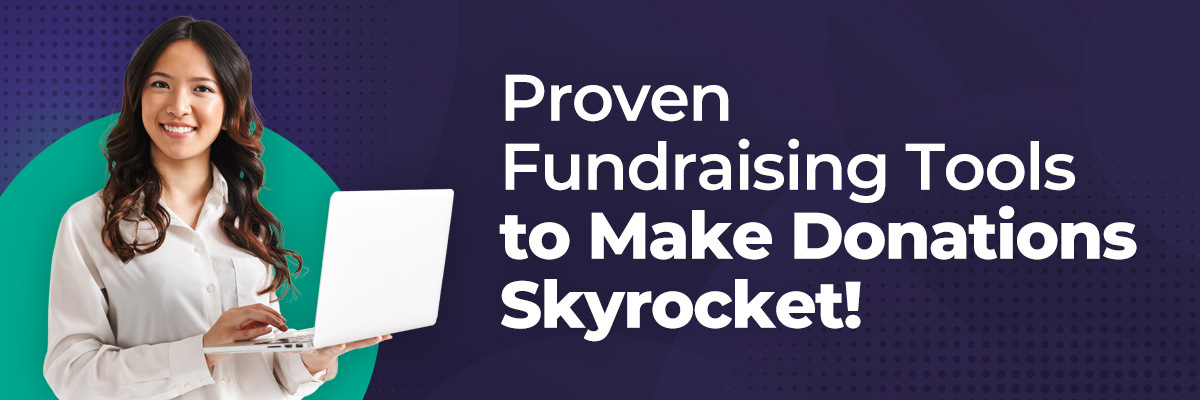
Organizing a nonprofit event goes beyond logistics. It involves connecting with your audience and championing the cause. When people understand and are affected emotionally, their support for the cause—donation, volunteering or advocacy usually comes most easily.
Everything from theme to activity should be synchronized with the audience. These people must feel that they are a part of something. Planning a successful nonprofit event is a journey. It starts with identifying the goals and the audience, proceeds with meticulous planning and finally, an event that furthers the cause is rolled out, creating memories.
Ultimately, every decision shapes the attendee experience to align with your nonprofit's values. Not all successful outcomes can be counted in dollars: success is also achieved when donors’ relationships are deepened and amplified. A painstakingly planned event apt to the mission brings credibility, stimulates action and nurtures support for the long term.
Table of Contents
Defining Your Event’s Purpose and Target Audience
Creating a Budget and Securing Sponsorships
Choosing the Ideal Venue and Format to Meet Your Goals
Coordinating Volunteers and Staff
Crafting an Engaging Event Program
Post-Event Follow-Up and Evaluation
Streamlining with Event Management Tools and Online Registration
What are the legal or insurance requirements for hosting a nonprofit event?
How can I find and collaborate with local vendors or service providers for my event?
What are the best practices for managing unexpected challenges or emergencies during an event?
How can I measure the impact of my nonprofit event beyond fundraising totals?
What are some innovative ways to engage corporate sponsors in nonprofit events?
100+ Free Tools & Templates to Boost Donations
Defining Your Event’s Purpose and Target Audience

Connecting the event with the purpose and mission of your nonprofit organization is critical for creating a unified, meaningful experience. A defined purpose ensures that each aspect of the event works toward the cause, which allows for effortlessly engaging audiences, getting funds and evaluating the inputs, outcomes and effects.
When an event is aligned with the mission of the organization, it builds authenticity and honesty, makes people trust a nonprofit and creates deep connections with supporters. Suppose you organize a gala to fund food banks or community meals; this will further buttress your mission of fighting food insecurity.
On the contrary organizing an irrelevant activity misaligned with your mission would confuse supporters and blur out the whole message. Another example is a fundraiser for the environment that could be done without paper to lessen the event's carbon footprint.
A defined purpose serves as a guide for making decisions concerning planning for a nonprofit fundraising event. It directs everything from location selection to the design of event activities.
Setting Event Goals and Objectives
Specific, measurable, achievable, relevant-tangible and time-bound (SMART) goals will ensure clarity and effectiveness because they are prerequisites to the activities of nonprofit events. Goals formulated in the line of the mission will give clarity and guidance in determining the efforts and resources to put forth.
For example, you can set a SMART goal to "raise $50,000 in three months for 500 poor students" instead of saying "raise funds." Targeted objectives are also instrumental in making the most of fundraising campaign efforts by sharpening strategies to meet particular outcomes.
Plan events like online auctions or peer-to-peer campaigns to reach out to donors and then direct any efforts toward achieving goals for the event and the organization.
Identifying Your Target Audience
Analyze donor data and feedback surveys and consider the community insights to identify your audience's demographic and psychographic characteristics. The difference is defined by measurable factors: demographics-factors like age, income, education and location; psychographics-values, interests and motivations.
Surveys and social media analytics often reveal what drives potential attendees to come and support your cause. Still on how to engage donors, once you understand your target audience, fine-tune the event for them.
For instance, a young professional audience may prefer a networking event with a live performance attached. At the same time, families would likely enjoy community fairs with events built in for children.
Remember to customize your communication — shorten your emails for working professionals or use more visual posts on social media channels for the younger audience. This approach will ensure that themes, activities and messages align with the preferences of the event attendees and ultimately result in a more substantial impact while engaging attendees in the event.
Creating a Budget and Securing Sponsorships

List all expenses for your event: venue rental, catering, marketing, permits, decorations, staff, etc. Research average costs in your area for these services, then apply a 10-15-percent buffer for unplanned items. If past events were held, use them to sharpen estimates.
While looking for sponsors, connect with the businesses who identify with your mission. Write a draft proposal for that business, specifying what it stands to gain from sponsorship — like placement of logos, mentioning name in events and gaining access to your audience.
Make a real case for how much their support is doing good in the challenge or cause. Clear, concise communications highlighting mutual value can convert would-be sponsors into enthusiastic partners.
Choosing the Ideal Venue and Format to Meet Your Goals
Different Types of Non-Profit Events
There are several event types for nonprofits designed to accomplish a given goal. You can organize a fundraising gala for your most generous donors, as they will appreciate an elegant atmosphere. A bespoke gala can be held with auctions or live performances to make it worthwhile and maximize donations.
Alternatively, community fairs or walkathons appeal to those who appreciate a good public activity. You'd agree that walking for environmental causes to demonstrate solidarity is remarkable. Plus, it shows that people of all ages are committed to making the world better.
Also of note are workshops or seminars. These are for educational purposes and can be harnessed by nonprofits focusing on raising awareness or developing skills. For example, a financial literacy workshop would suit the mission, focusing on economic empowerment issues.
Even virtual events, such as online webinars and giving days, are fairly, if not more so, affordable and reach out to international audiences. Choose your event type and be specific with your motives: raise funds, educate people or build a sense of community The event must effectively correspond to your audience's interests and your nonprofit's mission for maximum community engagement and effect.
Selecting the Right Format: In-Person, Virtual or Hybrid
Choosing the right type of event, whether in-person, virtual or hybrid, can often lead to a successful outcome for your nonprofit's efforts. Understand your goals, budgets and audience preferences, but keep it mission-centric.
In-person events are meant to build relationships and capture memories. Imagine a donor at a gala, mingling with other potential donors and moved by the speeches or at a live auction. Such moments create trust among these potential donors and ultimately result in loyalty.
Yet, events have costs associated with venues, catering and logistics, leaving them best suited for events that truly depend on intimate, face-to-face connections between attendees. Virtual events are good, especially when there is a need for accessibility and cost reduction.
For instance, one virtual panel discussion can have participants hailing from diverse locations all over the globe, yet to the minimum of costs. Nevertheless, engagement tends to be tricky and technology glitches would test patients.
Hybrid events reflect both ends of the spectrum: virtual and in-person events. Think of a great conference with keynote speakers speaking to an audience both live and through online participation. That said, the cost is always higher because great technical setups are needed for it to run smoothly.
The final and most crucial point is to keep your audience in mind when selecting the type of event. Is your audience likely open to online events, or would you prefer to meet in person? The proper format depends on what your goals are. Regardless, it ensures the event feels relevant, engaging and mission-inspired.
|
Format |
Pros |
Cons |
Ideal Use Cases |
|
In-Person events |
Builds deep connections, immersive
|
High costs; complex logistics
|
Galas, auctions, networking
|
|
Virtual events |
Cost-effective; broad accessibility
|
Lower engagement; tech challenges
|
Webinars, global campaigns
|
|
Hybrid events |
Combines reach with a personal touch |
Expensive; tech-intensive to execute |
Conferences, large fundraisers |
Coordinating Volunteers and Staff
The recruiting and training process of volunteers and staff is vital for efficiently operating your nonprofit event. Map out the roles and responsibilities to make sure everyone has a clear understanding of what needs doing. When considering hiring, evaluate the skills of different volunteers and staff members.
For example, if your nonprofit event is an auction, someone calm and with excellent communication skills will be ideal for bid handling. At the same time, an organized individual could assist in check-in or registration.
Training would not be limited to practical areas but would also include the mission and values of the event. Volunteers are part of your cause, so understanding how they play a part in the project is beneficial.
A short meeting or training session ahead of the event is sufficient to clarify logistics, answer questions and set expectations for a great experience. Assign roles—this is the best way to keep everything running smoothly.
Assign people to tasks according to their skills; everyone will feel more comfortable doing whatever they need. Consider making a schedule that shows check-in times, breaks and key responsibilities so there are no bumps.
Lastly, keep that energy positive and welcoming: happy, engaged staff and volunteers create a warm atmosphere where guests enjoy being present. When your team feels supported, they are more likely to contribute to making the event a meaningful success.
Crafting an Engaging Event Program
To create successful fundraising events for nonprofits, you’ll need to have a mix of activities that would suit different interests yet still stay true to your requirements as per your mission to create a unique, appealing and attention-grabbing nonprofit event.
Here are a few activities ideas for various events:
A keynote speaker
They can set the mood for your event and make an impression on attendees. It can inspire the audience to do more for your cause. Select an individual whose story will resonate with your audience and, at the same time, give increased credibility to your mission.
Interactive Workshops
These sessions allow your audience to learn a new skill or glean insight. Fine-tune your content to your audience's interests—a leadership workshop for professionals and a hands-on art session for creative supporters, for example.
Live performance
Music, dance or even a local theater group can add life to an event, not to mention break formality and, thus, create many memories.
Auction
Auctioning can serve as an event’s entertainment and, simultaneously, a fund-raising activity. Items auctioned should be unique to the mission but should have the characteristics to attract donor bids. These bids can raise funds for your cause.
A captivating event timeline is essential for any successful nonprofit event. We're talking about one just like this:
Welcome and Networking (30 minutes)
Warm refreshments and mingling would break the ice. It makes an ambiance setting.
Keynote Address (30-45 mins)
Select a speaker who will inspire and tie your audience to the mission. Stories work wonders here!
Workshop or Panel Discussion (45 minutes)
Curate activities or talk sessions that allow people to deepen their understanding or engage more fully with your cause.
Break (15 minutes)
It is time for the guests to charge and mingle.
Live Performance (30 minutes)
Liven it up with a local band, theatre act or other performance compatible with the event's staging.
Auctioning (30-45 minutes)
Items of interest that are mission-related or exclusive to excite potential bidders will amp it up.
Conclusion Remarks (15minutes)
Leave an impression with a compelling call-to-action message.
Choosing Activities Tips
Think about your audience when considering possible activities. There must be profound moments interspaced with active breaks to maintain momentum and have your audience feel connected to the mission.
Event Marketing and Promotion
Digital marketing is crucial in creating awareness of your non-profit event and impacting your audience because using the proper channels ensures communication of your message to the intended audience.
Many nonprofit leaders agree that Facebook, Instagram and LinkedIn are good platforms to stir interest in anticipated events. So, employ great images, catchy captions and regular video updates to create excitement for an event. Live videos or show countdowns can improve it, all while running targeted ads to precise demographics.
Email campaigns are another platform through which supporters can be reached personally. Use personalized headlines and clear calls to action, such as "Reserve Your Spot" or "Donate Now." Also, segment your email lists so that messages, such as those targeting donors, volunteers or community members, reach the right audience.
Content marketing nurtures interest for the long haul. Develop blog posts, videos or infographics illustrating how the event relates to the mission of your business: this builds trust and engages your audience.
Storytelling must be central to your marketing efforts. Stories of event successes or personal anecdotes from one of the nonprofit's beneficiaries can be used: they evoke emotional responses and compel people to action. For example, show how previous gala funds went to a life-changing program. The art of storytelling takes your outreach to the event much further than it is likely to go on its own.
Post-Event Follow-Up and Evaluation
It is vital to express appreciation after your nonprofit event. Send a few personalized thank you notes or even better, handwritten ones, to recognize the attendance and support of attendees.
Evaluate the event's success against attendance, fundraising total and level of engagement. Use a survey or feedback form to obtain participants' views on the event—on what went well and where it needs improvement.
This feedback forms the structure for future event improvement. Besides, keeping up with participants after the event is also about creating a long relationship with them. Regular updates and follow-ups for future events will go a long way in ensuring a solid donor relationship for your cause.
Streamlining with Event Management Tools and Online Registration
When planning events for nonprofits, event management tools help make things easy and smooth. They make all processes comfortable, like guest management, registration and communication.
Online event registration forms enable instant signup to the event while cutting manual work aside plus reducing data entry errors.
These tools allow the easy collection of the needed event attendee information, quickly track registrations and automatically send reminders. Thus, making the event experience smooth and orderly for both the organizers and participants.
Conclusion
Organizing successful fundraising events for nonprofit organizations is all about adequately coordinating all activities, beginning with stating your goals and objectives and continuing with the attendee engagement.
Getting the appropriate event format, arranging all the logistics and effectively managing promotion will all create memorable experiences.
With features like online registration, real-time data tracking and seamless communication, Vanco’s platform makes organizing your event effortless.
Ready to streamline your event planning? Explore Vanco’s event management software today and experience the ease of managing successful fundraising events that align with your nonprofit’s mission.
FAQs
What are the legal or insurance requirements for hosting a nonprofit event?
Before planning any nonprofit event, the first thing to do is to carefully examine its legal requirements, e.g., public space permits and an alcohol or concession permit. Insurance is paramount.
General liability insurance usually covers accidents and event cancellation insurance helps to protect against unforeseen issues such as weather disruptions. Consult a legal specialist to make sure everything is in order.
How can I find and collaborate with local vendors or service providers for my event?
Request recommendations from other nonprofits or local groups. Search for those vendors who match your mission and values. Also, clearly communicate your event's goals, budget and expectations. It is helpful to have contracts detailing the services, timelines and costs to avoid surprises.
What are the best practices for managing unexpected challenges or emergencies during an event?
Things don’t always happen as planned; therefore, a backup plan must be ready. Train staff and volunteers in how to respond to emergencies, such as medical issues and technical failures.
How can I measure the impact of my nonprofit event beyond fundraising totals?
Beyond numbers raised through fundraising, it is equally important to gather participant feedback and watch social media for engagement. Moreover, it is essential to know how the event propagates the bigger goals of your nonprofit, such as raising awareness among new donors.
What are some innovative ways to engage corporate sponsors in nonprofit events?
Develop personalized sponsorship packages that provide sponsors relevant ways to participate, such as exclusive access or speaking opportunities at the event. Show how their support benefits the cause.
100+ Free Tools for Nonprofits to Inspire Unprecedented Generosity!
We’ve put together 100+ pro tools and templates that are guaranteed to boost your nonprofit’s fundraising—no guesswork, no fluff. Here’s what’s inside:
- Word-for-word fundraising scripts that turn "no" into "yes"
- Fundraising letter, email and thank you templates for every situation.
- Event planning and evaluation tools including checklists, reports, evaluations, surveys and more
- Plug-and-play sponsorship proposals and templates sponsors can't resist
- Free design materials that make your events look professional
- Donation Receipt Templates for every type of contribution
- 7 AI bots to handle repetitive tasks and save you hours
The only question left: Are you ready to turn the chaos into success?
Act now!
5 Minutes to Fundraiser Success: The No-Hassle, Risk-Free Event Management Option for Nonprofits

Imagine setting up your next fundraising event in just five minutes. That’s what Vanco does for you—no learning curve, just a quick setup and an easy, intuitive system. You can try it risk-free and discover what thousands of nonprofits already know: event management doesn’t have to be a chore.











